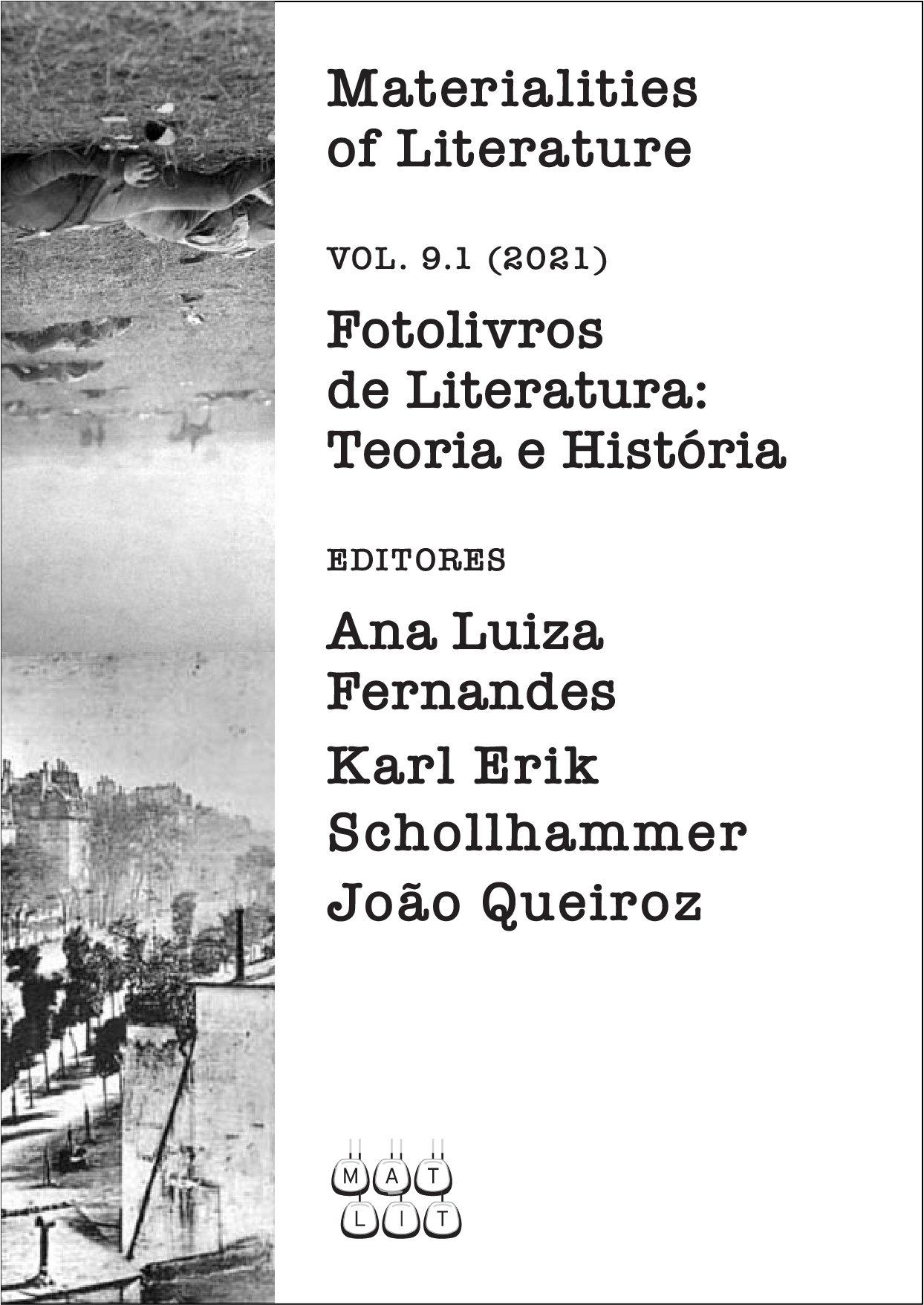Inventing literary photobooks
DOI:
https://doi.org/10.14195/2182-8830_9-1_1Keywords:
photobook, literary photobook, intermediality, photography and textAbstract
This article introduces a special issue of the journal MATLIT on "literary photobooks". As we know, the concept of photobook mixes up with many other concepts – artist's book, book art, bookwork, art book, book object, illustrated book, conceptual book, photographic book, photographic album – from several fields of research – intermediality and multimodality studies, comparative literature, photography theory, general semiotics, art theory, history of art. In this issue the reader will find several attempts to describe and analyze photobooks, and a discussion of how best to define and classify them, according to different theoretical perspectives and backgrounds.
Downloads
References
ATKIN, Albert (2016). Peirce. Abingdon: Routledge.
BADGER, Gerry (2015). “Why Photobooks are Important”. Revista Zum n.8. https://revistazum.com.br/en/revista-zum-8/fotolivros/ [10 November 2021].
BOULESTREAU, Nicole (1982). “Le Photopoème Facile: un Nouveau Livre dans les Années 30”. Ed. Henri Béhar. Le Livre Surréaliste: Mélusine IV. Lausanne: L’Age d’Homme. 164–177.
CLÜVER, Claus (2007). “Intermediality and Interarts Studies”. Eds. Jens Arvidson, Mikael Askander, Jørgen Bruhn & Heidrun Führer. Changing Borders: Contemporary Positions in Intermediality. Lund: Intermedia Studies Press 1. 19–37.
CULLER, Jonathan (1997). Literary Theory: A Very Short Introduction. Oxford: Oxford University Press.
HACKING, Ian (2004). Historical Ontology. Cambridge, MA: Harvard University Press.
LJUNGBERG, Christina (2010). “Intermedial Strategies in Multimedia Art”. Ed. Lars Elleström. Media Borders, Multimodality and Intermediality. Houndmills: Palgrave Macmillan. 81–98.
NOTT, Michael (2018). Photopoetry 1845-2015, a Critical History. New York: Bloomsbury Publishing Inc.
PEIRCE, Charles S. (1931-1935). The Collected Papers of C. S. Peirce, v. I-VI. Eds. Charles Hartshorne and Paul Weiss. Cambridge: Harvard University Press; v. VII-VIII. Ed. Arthur Burks. Same publisher, 1958. Charlottesville: Intelex Corporation. (Quoted as CP, followed by volume and paragraph.)
PHILLIPS, Constance (1936). Photopoems: A Group of Interpretations through Photographs. New York: Covici Friede Publishers.
PHILLPOT, Clive (1982). “Books/Bookworks/Book Objects/Artists’ Books”. Artforum 20 (May 1982): 77-79.
PHILLPOT, Clive (2013). Booktrek: Selected Essays on Artist's Books (1972-2010). Zurique: JRP.
WEINER, Lawrence (1989). “Books do Furnish a Room: Lawrence Weiner on Artist’s Books”. Umbrella Magazine, 11: 1–3.
Published
How to Cite
Issue
Section
License
Copyright (c) 2021 Ana Luiza Fernandes, João Queiroz

This work is licensed under a Creative Commons Attribution 4.0 International License.
MATLIT embraces full open access to all issues. Authors who publish with this journal agree to the following terms:
- Authors retain copyright and grant the journal right of first publication with the work simultaneously licensed under a Creative Commons Attribution- 4.0 International (CC BY 4.0) that allows others to share the work with an acknowledgement of the work's authorship and initial publication in this journal.
- Authors are able to enter into separate, additional contractual arrangements for the non-exclusive distribution of the journal's published version of the work (e.g., post it to an institutional repository or publish it in a book), with an acknowledgement of its initial publication in this journal.
- Authors are permitted and encouraged to post their work online (e.g., in institutional repositories or on their website) prior to and during the submission process, as it can lead to productive exchanges, as well as earlier and greater citation of published work (See The Effect of Open Access).
- A CC licensing information in a machine-readable format is embedded in all articles published by MATLIT.
- Attribution — You must give appropriate credit, provide a link to the license, and indicate if changes were made. You may do so in any reasonable manner, but not in any way that suggests the licensor endorses you or your use.
- No additional restrictions — You may not apply legal terms or technological measures that legally restrict others from doing anything the license permits.
Notices:
- You do not have to comply with the license for elements of the material in the public domain or where your use is permitted by an applicable exception or limitation.
- No warranties are given. The license may not give you all of the permissions necessary for your intended use. For example, other rights such as publicity, privacy, or moral rights may limit how you use the material.




